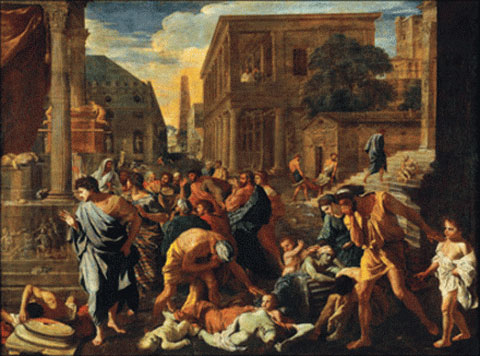Review the pandemic flu epidemic in history
Killing more people than war and other epidemics, the flu has long been a deadly enemy that has made mankind suffer.
Symptoms caused by flu viruses are described by Hippocrates, a famous Greek physician about 2,400 years ago. Under the ancient Roman Empire, historians also recognized many different types of flu.
Every year, the US Centers for Disease Control and Prevention estimates that up to 36,000 Americans die from seasonal flu, 10 times the number of people killed in the September 11 terrorist attacks and causing $ 160 billion in damage. double the cost after Hurricane Katrina. This influenza virus is mainly fatal in the elderly and children, and the cost of damage spreads evenly throughout the year so it is less noticeable.
However, after a few decades, the flu virus has been increasingly changing and spreading, causing a global epidemic. 1919 witnessed the most serious Spanish flu pandemic in history while public opinion condemned the media and argued that the virus's harm was just an exaggeration; They consider flu viruses unable to cause death or major damage.
In response to the epidemic of swine flu, Popsci.com has reviewed memorable milestones in the history of all human flu:
The first pandemic of humanity recorded in history (1580)
This is considered the first flu pandemic that people know. The epidemic originated in Asia, spread to Africa and attacked Europe. According to an article in the Journal of Applied Microbiology in 2001, the epidemic caused Spanish cities to become desolate and kill 8,000 people in Rome, Italy.

The picture of 'Epidemic at Ashdod' by Nicolas Poussin.Source: Wikimedia Commons
Even the flu epidemic has spread so badly that it led to the introduction of the word 'influenza', derived from the Italian phrase 'influenza del freddo', meaning 'the effect of colds'.
Spanish flu pandemic (1918 - 1919)

Isolation zone for influenza patients at Walter Reed Hospital during the epidemic in 1918 - 1919.
This is the most serious flu pandemic in human history. It is estimated that the pandemic has killed between 50 million and 100 million people, of which about 10% are young. This pandemic was ranked by the medical world on par with the plague that killed nearly two-thirds of the European population in the middle of the 14th century.
Asian flu in 1956 - 1958
From 1956 to 1958 was the year of marking Asian flu. Although it did not cause as much damage as the horrific Spanish flu, it also killed more than two million people, including 70,000 Americans.

A girl is gargling with salt water.Photo taken at Sagamihara Hospital, Japan when the flu broke out in 1957.
The pathogenic strain of the virus is type A virus, H2N2 originated from Russia and has been translated in 1889. Causing low mortality and short duration of survival, Asian flu is considered an untreatable epidemic. human civilization, but gives rise to the agents of seasonal flu.
Hong Kong flu in 1968

An experimental worker is injecting Hong Kong flu virus into chicken eggs.
This flu comes from Hong Kong caused by influenza A and H3N2 viruses. According to statistics from the Pandemicflu website, the epidemic has claimed 33,800 American lives. This number is less than the seasonal flu the previous year. Hong Kong flu developed from the previous Asian flu epidemic, so those infected with the flu virus in 1957 will become immune to the influenza strain in 1968.
'Strange' flu epidemic in 1976

President Gerald Ford vaccinated against the flu.
In February 1976, a soldier in Fort Dix, New Jersey died when infected with the H1N1 flu virus. Concerned that the H1N1 virus is of the same type as the virus that caused the pandemic 1918-1919, the US government called on citizens to participate in the pandemic vaccination program, a quarter of its population responded to the call. However, sadly, for every person who died from influenza virus infection, there were 25 people who died from the complications of the vaccine.
Great pandemic bird flu H5N1 in 2003
In 2003, the World Health Association announced four deaths from H5N1 influenza virus infection. Unlike other H5N1 strains, this bird flu has killed 60% of patients.

H5N1 influenza virus (yellow) in the kidney cells of dogs (blue).
The high death rate makes the world worry about the horrible Spanish flu return. However, it is fortunate that this flu virus is under control. Viruses are difficult to spread from person to person and can only spread to people who come in contact with live poultry.
- 9 monster epidemics in human history
- Find the cradle of HIV / AIDS pandemic
- Protected by antibodies from ... 1918
- 2020 pandemic flu attack humans?
- Ebola epidemic can attack Europe in the near future
- The most severe flu epidemic in 10 years, the US
- European colonialism in Africa caused the HIV epidemic?
- If the zombie epidemic happens, what is the safest shelter? Statisticians have the answer!
- Bananas are in danger of extinction because of a fungal pandemic
- Pandemic H5N1 has returned
- 5 mutations make bird flu a pandemic
- 3 diseases can become a global pandemic
 Green tea cleans teeth better than mouthwash?
Green tea cleans teeth better than mouthwash? Death kiss: This is why you should not let anyone kiss your baby's lips
Death kiss: This is why you should not let anyone kiss your baby's lips What is salmonellosis?
What is salmonellosis? Caution should be exercised when using aloe vera through eating and drinking
Caution should be exercised when using aloe vera through eating and drinking